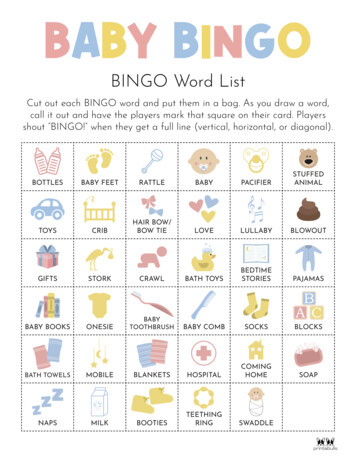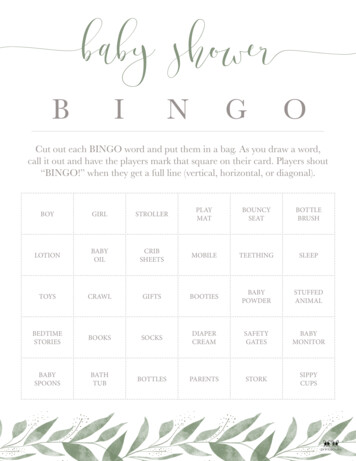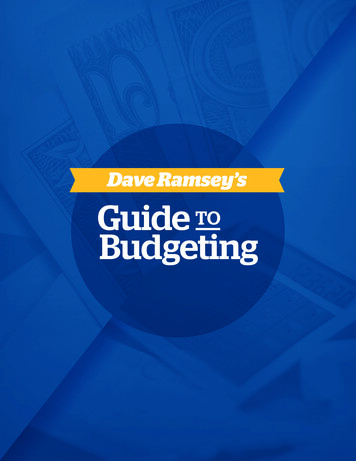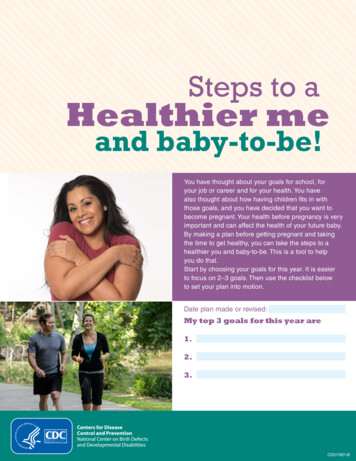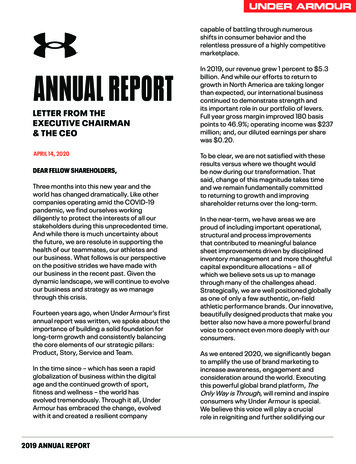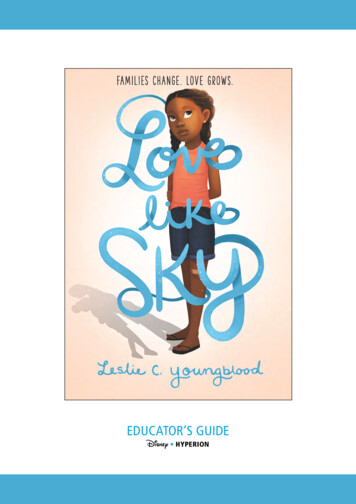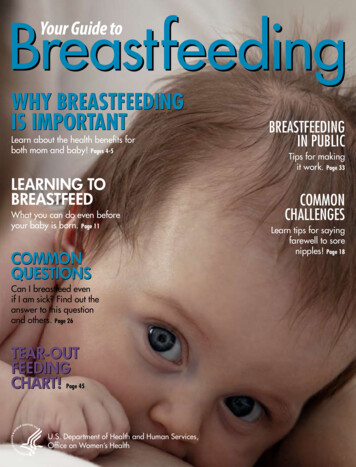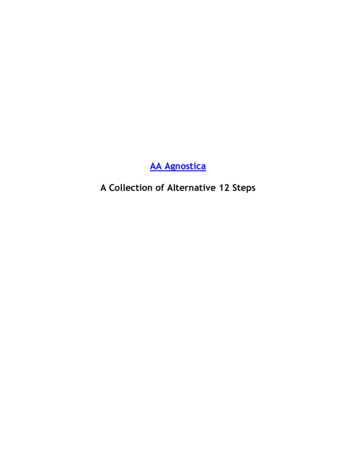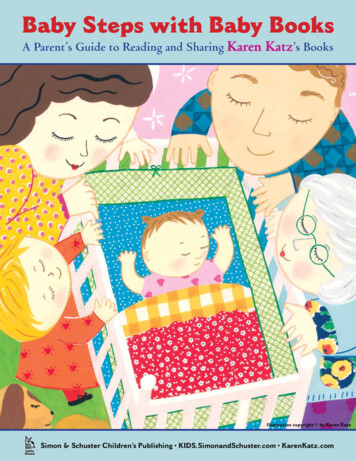
Transcription
Baby Steps with Baby BooksA Parent’s Guide to Reading and Sharing Karen Katz’s BooksIllustration copyright by Karen KatzSimon & Schuster Children’s Publishing KIDS.SimonandSchuster.com KarenKatz.comIllustration copyright by Karen Katz
Books byKaren Katz’s baby books introduce your infant or toddler to the joys of reading through colorfulillustrations and engaging, age-appropriate text. Her lift-the-f lap books, sturdy board books, and clothbooks delight the youngest of readers with titles that address baby’s favorite subjects: loved ones, toys,peekaboo games, and other babies!The tips and activities in this guide are meant to enhance the reading experience you share with your littleone. There are four categorical distinctions—Baby Step 1 to Baby Step 4—based on typical developmentalstages. These stages do not necessarily correspond with the age of your child, but rather where your childis developmentally. Use the Sharing Tips to help engage your child during reading time and the Activitiesto focus on more specific learning goals.Photo by Gary RichardsAbout Karen KatzKaren Katz has always made art—posters, quilts, costumes, prints, sculpture, painting,collage, book illustration, and design. After graduating from the Tyler School of Art inPhiladelphia she attended the Yale Graduate School of Art and Architecture, where shebecame interested in folk art, Indian miniatures, Shaker art, and Mexican art. She begandoing folk sculpture and working with fabrics. Karen is influenced by Chagall and Matisse aswell as folk art. She has written and illustrated more than forty novelty and picture books, including herbestselling Where Is Baby’s Belly Button? Her book Counting Kisses was a Children’s Book-of-the-MonthClub Main Selection and an Oppenheim Toy Portfolio Gold Seal Award Winner. Karen, her husband, andtheir daughter divide their time between New York City and Saugerties, New York. See the last page ofthis guide for a listing of all the Karen Katz books available from Little Simon.Illustration copyright by Karen Katz
Baby Step 1: Exploring the BasicsSharing TipsMake It RoutineIncorporate reading into your bedtime routine. For instance, after a bath and before a bottle or that lastcup of water, settle into a comfy spot and read a book together. Soon your baby will learn to expect andanticipate the reading experience.Sit in FrontTry putting your child in front of you rather than in your lap when reading. This way your baby can focuson your face as well as the book. Your child will soon make the connection that you are reading from thebook.Turn the PageIntroduce your baby to the basic concepts of reading a book. Show your baby how you open the book tothe first page before reading. Say “Open the book,” as you do so. Model how you turn the pages of thebook from right to left. Say “Turn the page” every time you do so. When you have finished reading thebook, say “All done.” Soon your child will know how to open the book, turn the pages, and close the bookall by himself.Lift the FlapWhen reading a lift-the-flap book, encourage your child to lift the flaps. In the beginning, place yourthumb under the flap to call your child’s attention to it. Then allow your child to lift each flap on his or herown to discover a fun surprise.Play PeekabooSay “peekaboo” each time you lift a flap.Illustration copyright by Karen Katz
Baby Step 1: Exploring the BasicsActivitiesTexture SensationsAt this stage in development, your baby is very interested in textures and exploring objects with bothhands and mouth. Let your baby fully explore the book you are reading together. Introduce a cloth booklike Baby’s Day to your child. The soft pages and crinkly textures will encourage your baby to play andinteract with the book. Touch-and-feel books like Baby at the Farm or Beddy-Bye, Baby are also great forexploring.The Nose KnowsYour child is interested in learning the names of things, such as the parts of the body. Read a storytogether, like Where Is Baby’s Belly Button?, and begin to help your child identify his or her own body parts.For example, point to your nose and say “nose,” and then point to your child’s nose and say “nose.” Youcan also point to the baby’s nose in the picture. Keep it simple. Beginning a conversation about a nose,what it does, and how it works, is too advanced.Try to focus on one body part per week. Throughout that week, call attention to your nose or your baby’snose during everyday activities. Then focus on another body part the next week. Don’t forget to reviewyour child’s understanding of “nose” from time to time.A Hat Is a HatWhile reading a book together, have ready a few of the objects mentioned in the book. For instance, inPeek-a-Baby, a ball, hat, and teddy bear are mentioned. When you read a page that discusses the ball,show a real ball to your baby. Help your child make the connection between the written word and pictureand a real object.Look at the Sound I MakeHelp your child practice consonant and vowel sounds and emerging words with the following activity.While reading a book with simple sounds like ba-ba and ma-ma, as in What Does Baby Say?, direct yourchild’s attention to your mouth. For example, place your index finger on closed lips when you make them sound in ma-ma. Draw an imaginary circle around your mouth when you say the oh in uh-oh. Lightlytouch your lips when you make the b sound in ba-ba. You want your child to watch how you make thesound first and then to make it himself. Using hand-over-hand assistance, help your child make the samefinger motions when making the various sounds.Using GesturesIncorporate gestures into your read-aloud experience. You may use Standard American Sign Languageor popular “baby signing” methods, or make up your own signs. It is especially helpful to seat your babyin front of you, so your baby can see your face and gestures while you read. For example, when readinga book such as What Does Baby Say?, place your hands against your cheeks when you say “uh-oh,”or use your hands to indicate crying eyes when you say “waah-waah.” Your child will learn a way ofcommunicating to you during the time that verbal communication is emerging.Illustration by Karen Katz
Baby Step 2: Discovering and UnderstandingSharing Tips rovide a ChoicePAs your baby becomes more familiar with the Karen Katz books, begin to offer a choice of which bookto read. Hold out two books and say,“Which book do you want?” Then read the book your child hasindicated.Lift the Smaller FlapsContinue to help your child improve fine motor skills with more lift-the-flap books like those in the Baby’sBox of Family Fun set, including Daddy and Me and Where Is Baby’s Mommy? These books have smallerflaps requiring greater hand-eye coordination and dexterity.Ask Simple QuestionsWhile reading books together, ask simple questions about what you see on the page. Many of theKaren Katz books already have questions built into them, such as “Where is Grandpa’s favorite spoon?”in Grandpa and Me, that encourage readers to lift the flap to find the answers. Ask your child otherquestions to monitor understanding, such as “Where is Grandpa?” and “What is this?” when pointing topictures of objects your child knows.Read It AgainWhat if your child wants you to read the same story for the millionth time? Great! Your child is showingyou an interest in a book and building an important connection to literacy. At this stage in development,you want to develop your child’s ability to use his or her prior knowledge or understanding of the storyto focus on other aspects of the book, including sound and word recognition. Don’t be afraid to read thestory again and again to develop other skills.Illustration copyright by Karen Katz
Baby Step 2: Discovering and UnderstandingActivitiesFamily Flash CardsRead a book to your child about family members, such as Grandma and Me. Afterward, showphotographs of immediate family members and extended relatives to your child. Name the people in eachpicture. Make copies of the photographs and paste each person’s picture on a single index card. Below thepicture write the person’s name. Have fun looking through the cards with your child. In addition, you mayarrange the cards in order by family relationships, age, or alphabetized names.Free to ExploreAllow your child to explore and discover the surprises in any of the touch-and-feel and lift-the-flap bookson his or her own. Then encourage the same curiosity and motivation to learn by putting together amystery box. Gather a few toys your child hasn’t played with in a while as well as a few safe householditems, such as a wooden spoon or a lightweight measuring cup. Place the items in a cardboard box andclose it. Allow your child to find and open it to discover what’s inside. Repeat the activity with new items.You may also use a smaller box, and then hide it somewhere in the room to encourage further discovery.Little LabelsAs you are reading together (try Baby’s Colors or Baby’s Shapes), point to the objects in the pictures andlabel them for your child. Say the name of each object slowly and clearly. Make sure to focus on only afew objects during each reading. Then use the same idea in your home by creating little labels. Writethe word table on an index card and tape the card to a table. Write the word chair on a card and tape itto a chair. You can do this with colors and numbers as well. Start with only a few labels and then slowlyincrease the number. Remember to read the label aloud each time you and your child use the object.Illustration copyright by Karen Katz
Baby Step 3: Reading and Discussing TogetherSharing TipsIt’s Your BookWhile you read together, have your child hold the book and be in control of turning pages and lifting flaps.Make your child feel as if he or she is reading independently. Demonstrate an idea of the reading pace byfollowing the words with your finger as you read. You might also guide your child’s finger along the wordsas you read together.You Read to MeEncourage your child to read the book to you. Although your child will be pretending to read, he or shewill have the chance to practice the motions of reading and solidify the understanding and importance ofthe printed word.Wonder AloudPeriodically while reading together, make statements such as “I wonder what will happen next?” or “Thisis a funny story.” Reveal to your child what goes on in a reader’s head while reading a new story. This willfamiliarize your child with the processes of making predictions and forming evaluations while reading.Illustration copyright by Karen Katz
Baby Step 3: Reading and Discussing TogetherACTIVITIESA Happy HolidayPreparing for holidays is an excellent way for your child to learn your family traditions. Read a book aboutthe holiday, such as Where Is Baby’s Pumpkin? or Where Is Baby’s Dreidel?, during the month in which theholiday occurs. Show your child the day of the holiday on a calendar. Cross the days off as you get closerand closer to the holiday. Show your child the decorations or clothes associated with the celebration.Prepare a special food your family enjoys at this time. Give your child nontoxic clay or dough to pretend tomake such foods along with you. Involve other family members in the preparations and celebrations.Potty TimePotty training can be difficult for any child, and it may take some time before he or she understands it.Talking about potty training before starting the process can ease some of the confusion and anxiety.Read a book such as A Potty for Me! together to introduce the subject. Make supportive statements whilereading the book, such as, “Look at that baby using the potty!”or “Wow! That baby went potty all byhimself.” Read the book through several times to familiarize your little one with the potty training process.Fun FlapsHelp your child create a lift-the-flap book. Fold a few sheets of paper together horizontally. Staple theinside crease. Staple an extra sheet of paper to every right-hand page in order to create the flaps. Helpyour child draw a picture of a simple object, such as a ball or a toy car, to appear underneath each flap.You may also cut pictures out of magazines and glue them to these pages. Write the name of the objecton the flap or on the left-hand page. Encourage your child to create designs or scribbles in the book. Havefun lifting your homemade flaps.Illustration copyright by Karen Katz
Baby Step 4: Explore the Parts of a StorySharing TipsI t’s Time to RhymeWhile reading a book together, pause after reading simple words, such as at, my, or can. Help your childidentify words that rhyme with the simple words, such as hat, mat, sat, and cat for at. Together make up asilly rhyme using all the words you identified.Clap TogetherIntroduce your child to syllables while reading. Say, “Let’s listen to the beats while we read. Let’s clapon the beats.” Model clapping out the syllables in a word you have read. Then model clapping out thesyllables in a sentence. In each instance, have your child repeat after you.Name the LetterChoose a letter to focus on before you begin reading. For example, say “Let’s look for all the m letters.”Then, after reading a page, pause and ask your child to point to any m’s on the page. The next time youread together, choose a different letter and repeat the activity.Retell the Story to MeAfter reading a narrative together, such as Where Is Baby’s Mommy?, ask your child to retell the story toyou. Help your child understand and recall the beginning, middle, and end of the story. If your child ishaving difficulty, review a few of the pages from the book.Look at the CoverBefore reading a new book, take some time to study its cover. Read the title to your child and ask what heor she thinks the story will be about. After reading, remind your child of this prediction. Discuss whetheror not the prediction was correct.Counting/ColorsPoint out colors and counting concepts when appropiate. Ask your child to point to two things that arered, or you can say, “Let’s count all of the blue things on this page.” Soon he/she will start looking forthese on his/her own.Illustration copyright by Karen Katz
Baby Step 4: Explore the Parts of a StoryACTIVITIES tamp Your FeetSPlaying simple games during reading can help engage your child in the learning experience. Read a bookabout body parts, such as Wiggle Your Toes or Toes, Ears, & Nose! Encourage your child to manipulate all ofthe flaps, movable parts, and textures. Pause after each page and have your child get moving! Say, “Stampyour feet” or “Flap your arms.” By doing so, you’re reviewing body parts but also teaching your child tolisten carefully and follow directions. Afterward sing the song “Head, Shoulders, Knees, and Toes” withyour child. Or, grab a copy of Shake It Up, Baby! and watch your little one dance!Count with MeWhile counting books, such as Counting Kisses, can be shared with your child at any stage in development,your child may benefit most from counting and mathematical exercises at the age of three or four. Beforethis time, your child will probably know the words related to numbers, but may not understand a word’srelationship to the quantity of objects. Read a counting book together, such as Daddy Hugs or MommyHugs, and count objects in the pictures or patterns together. Point to the numbers on the pages andhave your child trace the numbers with an index finger. Once your child is comfortable with counting,encourage him or her to count objects in your home or objects that you see while taking a drive in the car.And Then What Happens?Read a narrative book together, like Where Is Baby’s Valentine? or Grandma and Me. After the story hasended, ask your child what would happen next in the story. Encourage your child to be creative whenthinking about this next event or part to the story. Help your child write down his or her ideas on a sheetof paper and draw pictures to go along with this new part of the story. The next time you read the booktogether, read this new chapter as well.Thank you for using this guide. We hope it helps makereading time with your little one a daily routine and thatyou’ll continue to choose the perfect book for your babyfrom the sweet selection of Karen Katz titles published byLittle Simon.Sincerely,Simon & Schuster Children’s PublishingFor more activities and information on Karen Katz books,visit KIDS.SimonandSchuster.comIllustration copyright by Karen Katz
Read all of the Karen Katz Books from Little Simon!Lift-the-Flap Board BooksWritten byMarion Dane BauerHoliday-Themed Lift-the-Flap Board BooksBoard BooksMiscellaneous FormatsTouch-and-feel booksSimon & Schuster Children’s Publishing A CBS COMPANYKIDS.SimonandSchuster.com KarenKatz.comIllustration copyright by Karen Katz
Introduce a cloth book like Baby’s Day to your child. The soft pages and crinkly textures will encourage your baby to play and interact with the book. Touch-and-feel books like Baby at the Farm or Beddy-Bye, Baby are also great for exploring. The Nose Knows Your child is interested in learning the
